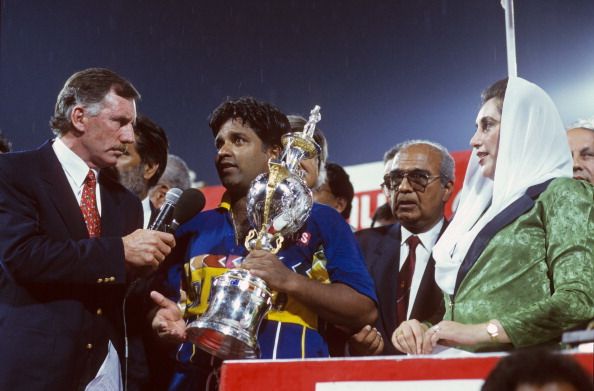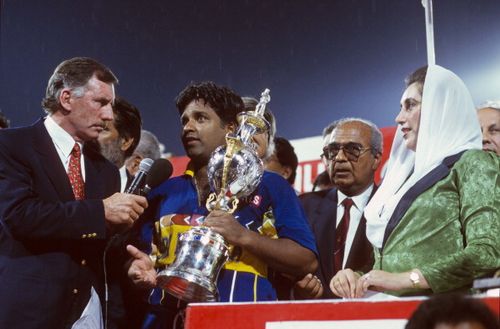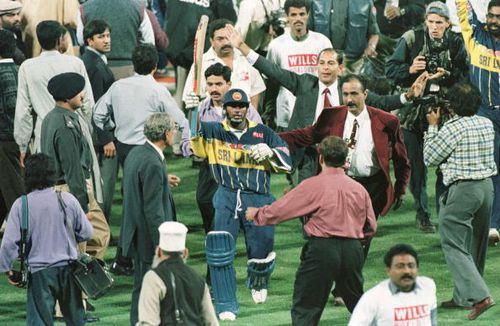
Sri Lanka’s 1996 World Cup triumph - A day when David walloped Goliath

Sri Lankan captain Arjuna Ranatunga with the World Cup trophy.
On 17th March, 1996 an inspired Sri Lankan team was playing its first World Cup final against Australia who were considered favourites to win the match. The islanders rallied around Aravinda de Silva and scripted their most famous win in a clinical fashion that saw them emerge as the world beaters. Here’s a look at the epoch making event in Sri Lankan cricket history, their Lahore conquest.
Sri Lanka was in the news for all the wrong reasons before the World Cup. The safety of the country was being questioned by a few teams. When West Indies and Australia refused to play their games at Colombo, the entire country of Sri Lanka felt let down and cheated. The angry cricket aficionados in Sri Lanka wanted their team to beat Australia.
The trash talk:
Before the start of the match, there were reports of Sri Lankan captain Arjuna Ranatunga saying that Australian golden boy Shane Warne was over-rated. Ranatunga was an inspiring captain and had the full support of the team. He had to endure a lot of pain when Sri Lanka visited Australia the previous year. Sri Lankan off-spinner Muttiah Muralitharan was no-balled continuously by Australian umpire Darrell Hair. It was a tough time for Sri Lanka on the tour. Ranatunga wanted to exact revenge and he set the ball rolling with his bold statement.
Challenging history:
The last five editions of the World Cup had seen the teams batting first winning the cup. When Ranatunga won the toss, he decided to bowl on a placid Lahore track. Sri Lanka’s strength throughout the tournament had been restricting the flow of runs by employing slow bowlers in the middle overs. The other tactic that caught teams off-guard was their cavalier approach in the first 15 overs when the field restrictions were on.
An early wicket and a big second wicket stand:
Sri Lankan opening bowlers Chaminda Vaas and Pramodya Wickramasinghe were not getting any lateral movement. Batting looked simple. Australian opener Mark Waugh flicked an innocuous Vaas delivery to square-leg where Sanath Jayasuriya pouched a safe catch.
Mark Taylor was looking good. His pull shots off Vaas showed glimpses of his brilliance. Ricky Ponting also got his eye in and played wonderful drives and picked up singles regularly.
The Australian captain, in the 27th over, played a slog sweep off part-time off-spinner Aravinda de Silva straight into the hands of deep square-leg. Yet again a hundred eluded him. It was the 27th time in his 96 ODI matches, that Taylor had scored a fifty. But Taylor’s 83-ball 74 had given Australia a solid foundation to score a big total. But the Sri Lankan spinners began to prosper. Ponting was out bowled off Aravinda for 45. The delivery turned in sharply to beat a well-settled Ponting.
Loss of momentum:
The pitch then started to show a different colour. Shane Warne was promoted up the order to increase the scoring rate. But he was stumped off Muralitharan. Dharmasena then had Steve Waugh caught by Aravinda. Stuart Law was dismissed as well caught by Aravinda. The part-time off-spinner Aravinda then came into the attack and bowled ‘keeper Ian Healy through his gate. At seven wickets down for 205 runs, Australia looked in danger of being bowled out. From one for 137 in the 27th over to such a precarious position, Sri Lanka were all over Australia.
Resurrection:
Michael Bevan (36 off 49 deliveries) gave Australian score an air of respectability. Australia registered 241 runs for seven wickets in their allotted quota of 50 overs.
Sri Lankan run-chase: Openers dismissed early
Throughout the tournament, openers Romesh Kaluwitharana and Sanath Jayasuriya had attacked the bowlers, forcing them into submission. Australia had to make early inroads before the duo took the game away from them.
Jayasuriya in particular had plundered Indian attack in the group stage and destroyed England in a matter of minutes, scoring 79 off 76 balls and 82 off 44 deliveries respectively. But Jayasuriya was run-out on nine and Kaluwitharana was out when he miscued a pull shot off Damien Fleming. At 23 for two in the seventh over, Australia had a spring in their stride. In walked Sri Lanka’s most reliable batsman Aravinda de Silva.
Gurusinghe and Aravinda stitch an important alliance:

Aravinda de Silva played a once-in-a-lifetime innings.
Aravinda had played one of the best counter-attacking innings in the semi-final against India. He had scored 66 in no time and his inspiring batting tilted the game in the island nation’s favour at the Eden Gardens. In the final, as a fielder he had pouched two catches and his three for 42 bowling figures tilted the game in Sri Lanka’s favour. The entire nation was waiting for “cherry-on-the-cake” kind of moment from Aravinda. For that, he had to win the game for the team. Aravinda did just that. Right from the first delivery, he looked in total control.
The third wicket partnership added 125 off 92 deliveries. Gurusinghe was dropped three times. But he never let that play in his mind. His 99 ball 65 was an important innings in the scheme of things.
Ranatunga’s cameo sealed it for Sri Lanka:
When Ranatunga walked in the middle he was welcomed by a look of anger by Warne. Ranatunga was waiting for Warne’s introduction into the attack. When the leggie bowled his first ball to the Sri Lankan skipper, he smashed the ball past Warne. That deflated the Australian spirits.
Aravinda scored an unbeaten 107 and sealed the deal for Sri Lanka. For his classic performance with the ball and his one-in-a-lifetime innings, Aravinda won the man of the match award.
This was Sri Lanka’s watershed moment in their cricketing history. They redefined the way ODI cricket was being played. All the members of the team clicked at the right time.
Even after 17 years, no one denies that this was an all-time high moment in the lives of not just Sri Lankans cricketers, but also the common citizens.